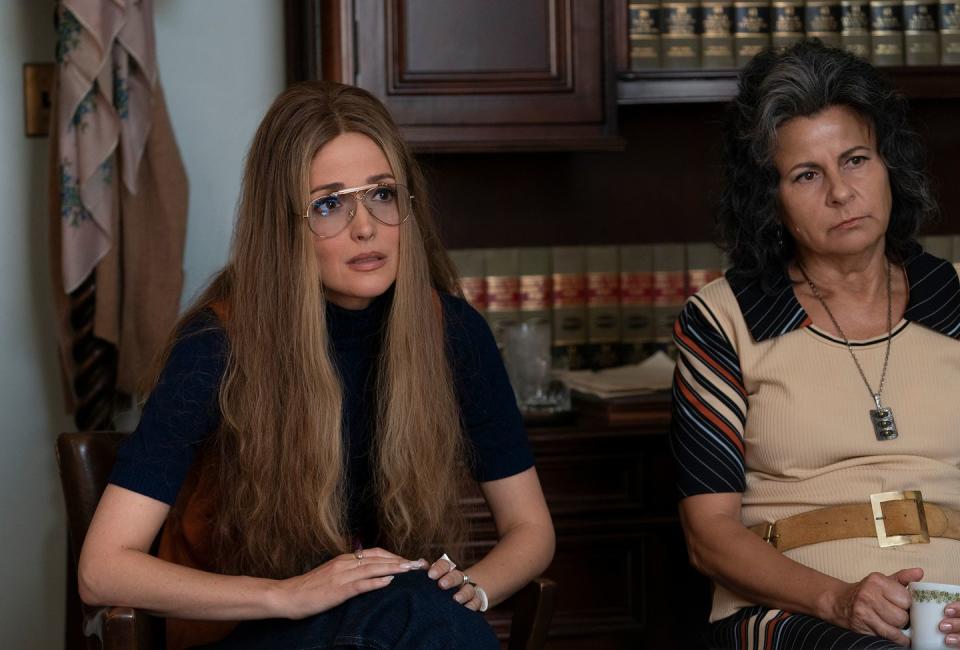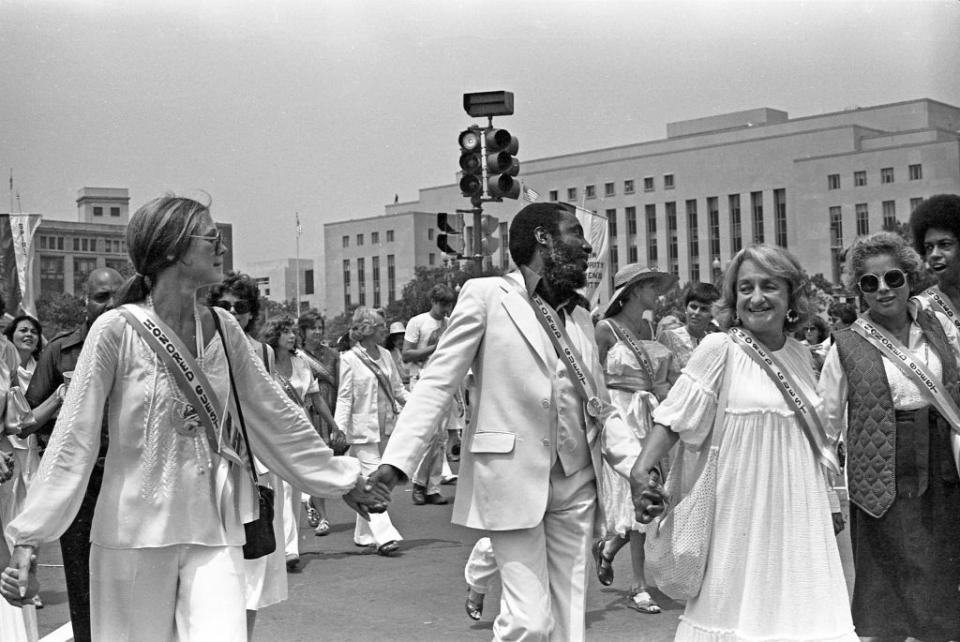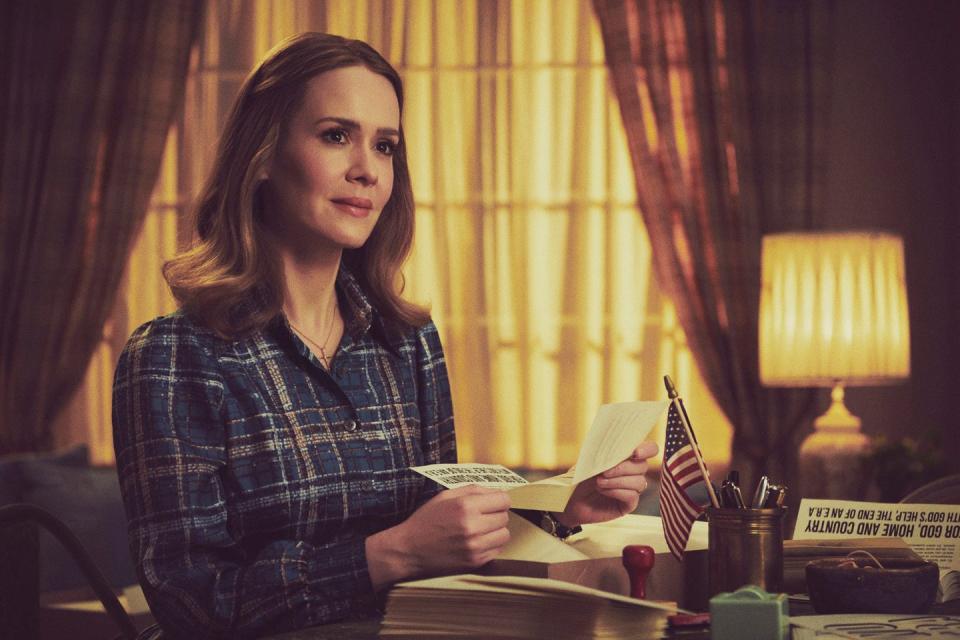How Mrs. America Recreated Gloria Steinem's Iconic Hairstyle

When you picture Gloria Steinem, two trademarks likely come to mind: her hair and her glasses. With her long locks—textured, highlighted, teased in the back—and aviators fixed over her front strands, the famed feminist activist has definitely cultivated a singular, apparently effortless look.
But the task of recreating it for TV? Not so effortless. That's where Anne Morgan comes in. The Academy Award-winning hairstylist was eager to take on the challenge for Mrs. America, the new FX on Hulu series. The show revolves around the fight to ratify the Equal Rights Amendment (ERA), following activists on both sides of the political battle, including STOP ERA founder Phyllis Schlafly (Cate Blanchett) and whole host of second-wave feminists, like Steinem (Rose Byrne), Betty Friedan (Tracey Ullman), Shirley Chisholm (Uzo Aduba), Bella Abzug (Margo Martindale), and Jill Ruckelshaus (Elizabeth Banks).
Known for her work on Bombshell, Gangs of New York, Walk The Line—and perfecting that hairdo from There's Something About Mary—Morgan headed up hairstyling for the series' all-star cast (aside from Blanchett, who was styled by Kerry Warn). For the pro-ERA activists like Steinem, that usually meant creating "fuzzy" and "textural" looks; these women were not having their hair set in salons as often and some, including Friedan, let their hair go gray.

Far and away, the most intricate wig Morgan tackled was for Byrne's Steinem—and, accordingly, she enlisted world-renowned wigmaker Martial Corneville to create it. After taking a plaster cast of Byrne's head to ensure accurate fit, Corneville tied each hair into the wig individually, for the most natural look. Even deciding what kind of hair to use was a drawn-out process, with Corneville and Morgan hoping to achieve the same "fuzziness" and "curly" texture as Steinem's locks. After the wig arrived, then began the extensive process of cutting, highlighting, and styling the hair—so as to resemble Steinem's locks, but also hold up in the Toronto humidity for filming. The extra effort was well worth it. "We had to get the hair right because it was so much part of her silhouette," Byrne said on a recent press call, praising the results as "phenomenal."
The actress was trusting, letting "the process evolve," said Morgan (perhaps because, as Morgan noted, Byrne had already heard good things about Corneville from friend Glenn Close).
But even if Byrne's wig required the most effort, it was still just for one character out of the 98 wig-wearers under Morgan's purview. Though Morgan's work was demanding, it was crucial in maintaining the show's historical accuracy.
Guiding Morgan's aesthetic choices was series creator Dahvi Waller's request to "make it look real," Morgan explained. "So that it had that blend, where you had real footage mixed in with what was being shot. It felt one in the same."

Morgan's personal attachment to the period proved to be a resource. "In this particular case, being a child of the ’60s and growing up in the ’70s myself, I have reference points of knowing what the hair was like of my mom and my cousins or myself."
She also knew that everyone had to have their own thing. "It was pre-MTV and the washing out of individualism. You wanted to be individual. You wanted your hair to make you look individual," Morgan said. "Each one of these characters has totally different hair. Nobody looks like a whole group that all looks the same—everybody’s different."
Still, some styles have more in common than others. Cultural differences between the feminists and the anti-ERA women divide their looks into separate camps. If the progressives had "fuzzy" and "textural" hairstyles, Morgan explained that for the conservatives, "we tried to keep the silhouette more conservative and a little bit more round, tighter, and more constrained."

An exception can be found with Morgan's creation for the very progressive Shirley Chisholm. The real-life Chisholm wore wigs that looked, well, like wigs—and Morgan tried to convey the idea that Chisholm chose this hairstyle in order to conform to her mostly male, political surroundings. "Her hair wasn’t natural. Her hair was in a silhouette that felt familiar to [white men in politics] and noticeable when she would walk in a room," Morgan said. "It altered her height—she’s little—it made her bigger in the room."
To craft every updo, pixie cut, and set of bangs, Morgan worked 93-hour weeks. Apparently, it was well worth it: Morgan loved the project from the moment she got her hands on the first script. "Reading it was exhilarating," she said. "All these cool, empowered women—that’s what was amazing.
"It was really an honor and these women—the actresses—I just freaking love them," she said, pausing. "And the actors. But, you know, it’s a chick film and it was great."
You Might Also Like

